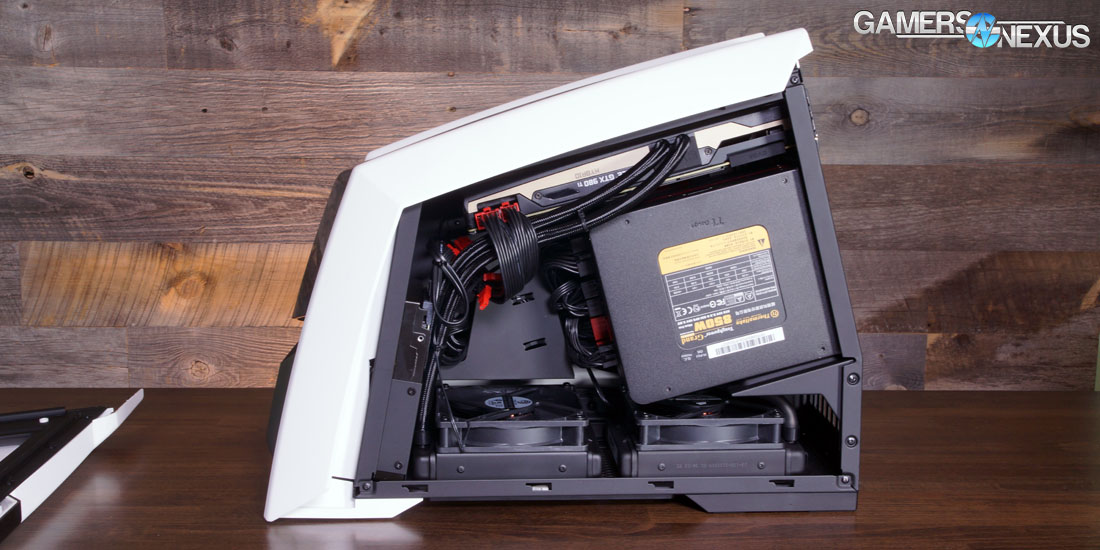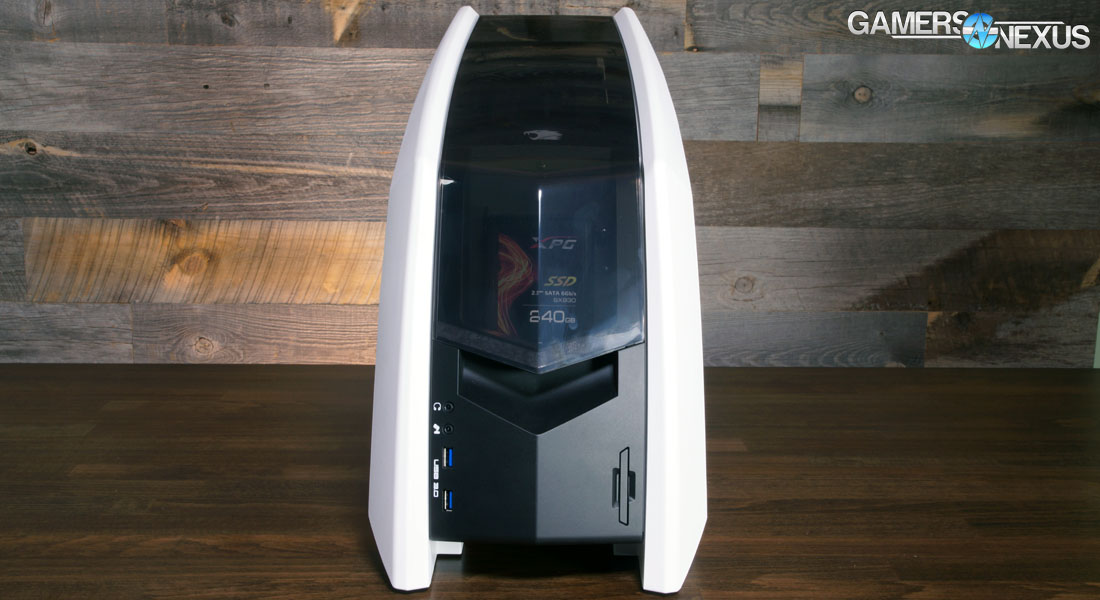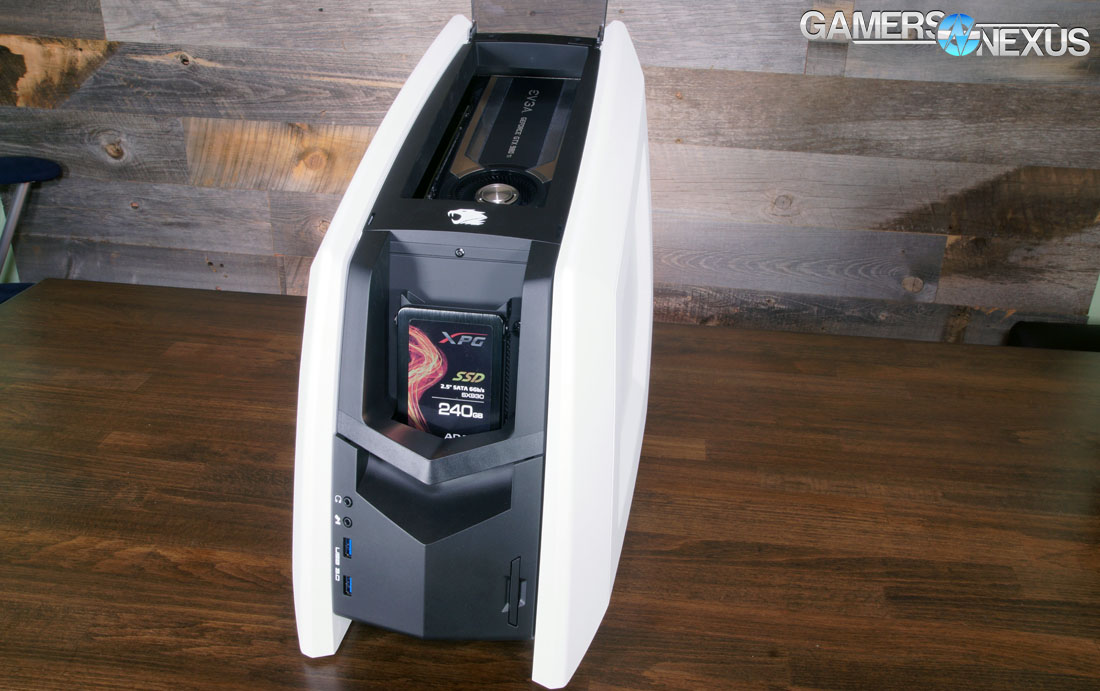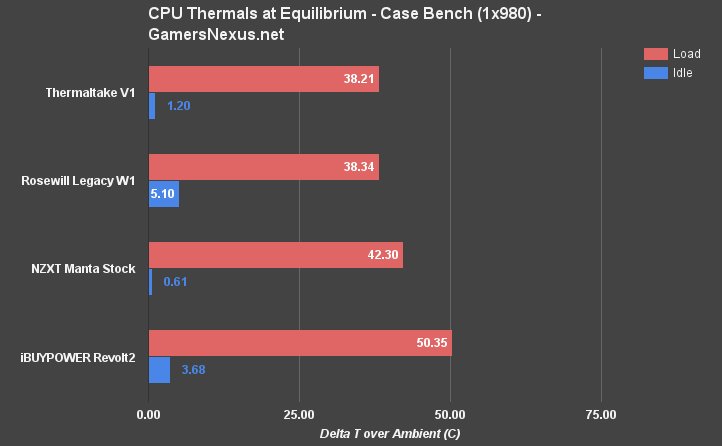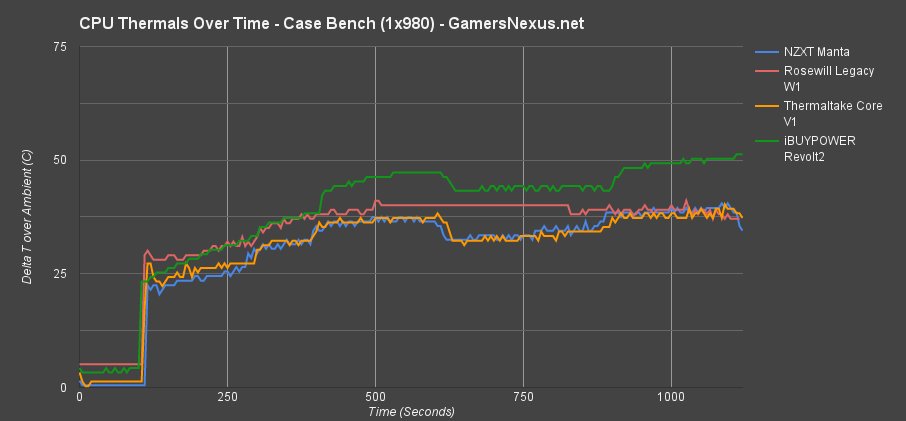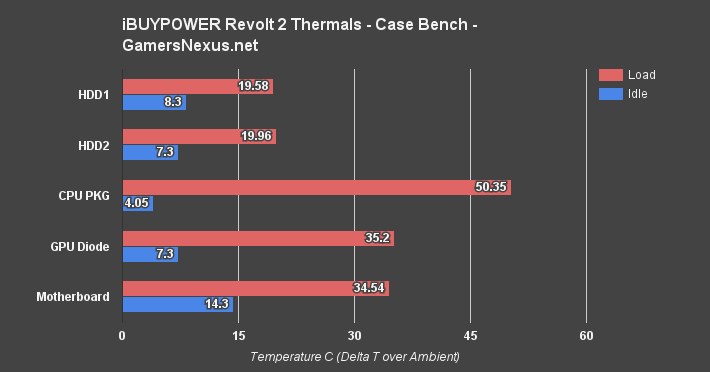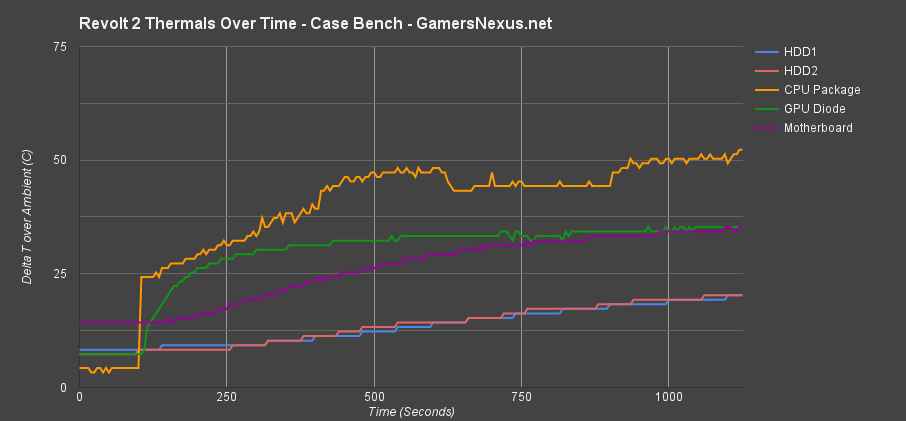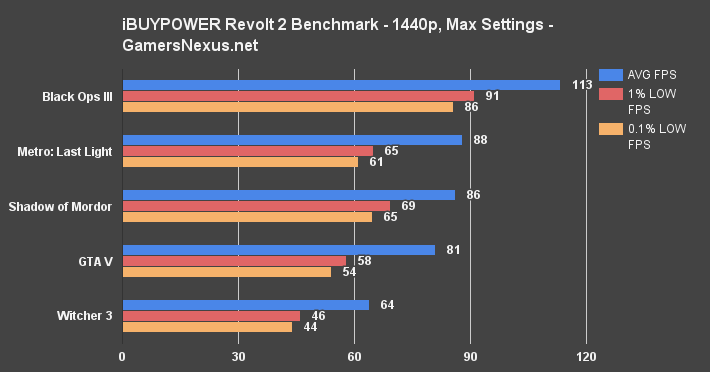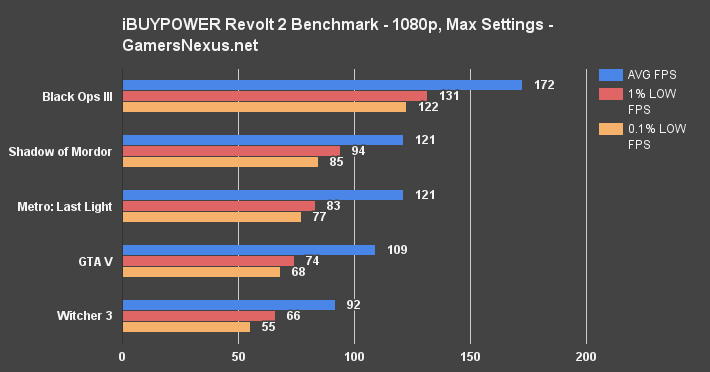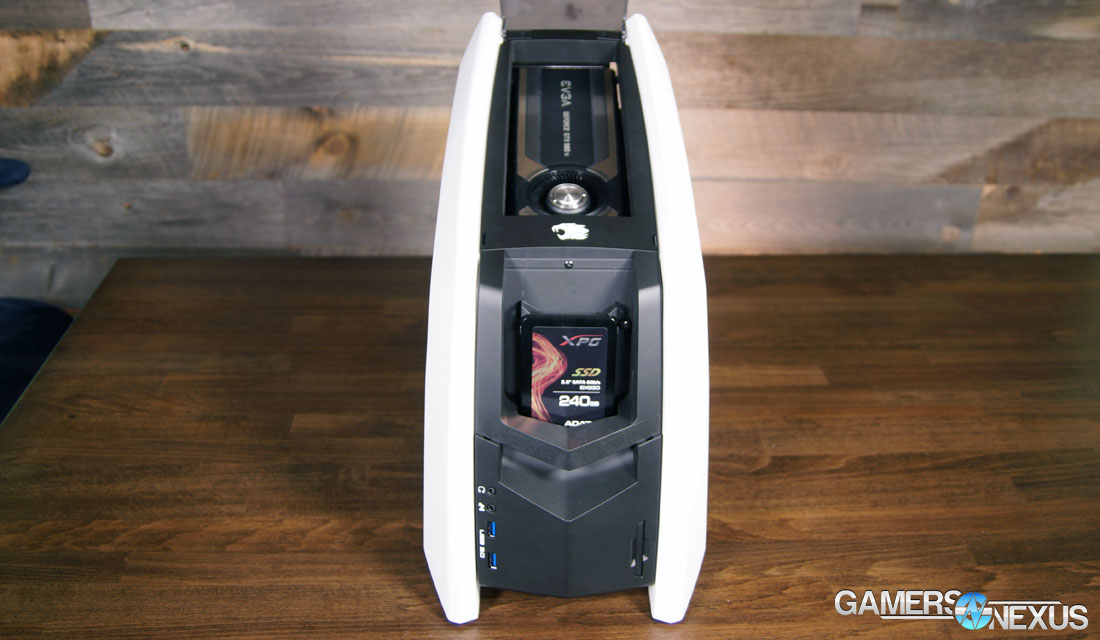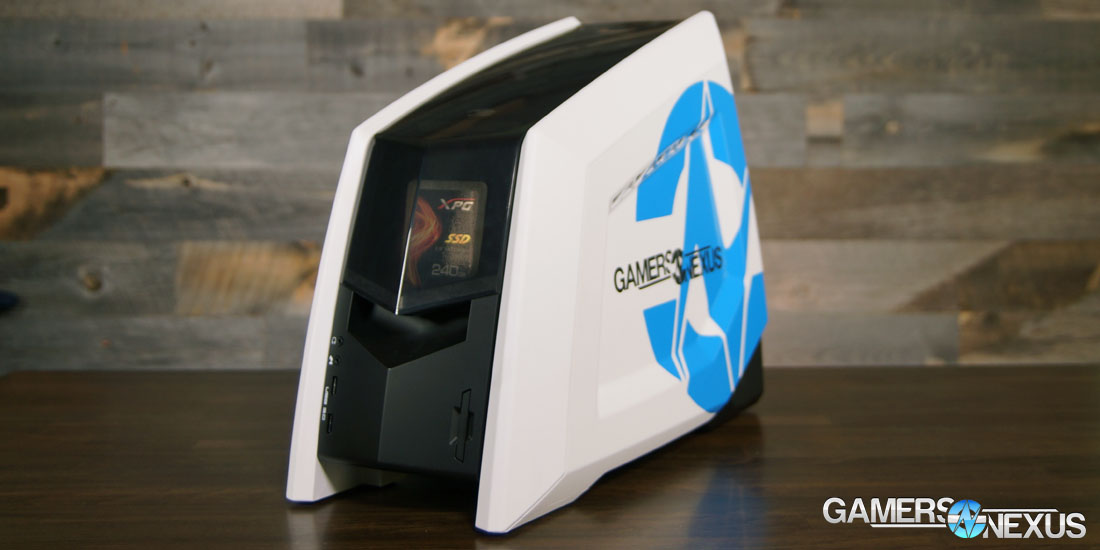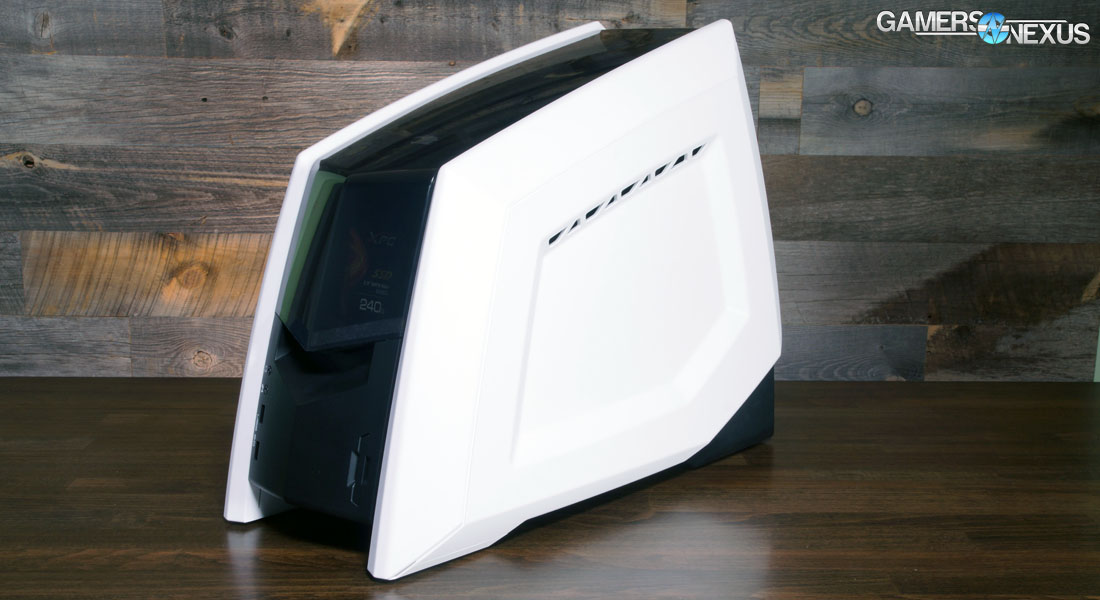System Integrators (SIs) generally don't make much – they're builders, not manufacturers, and source parts at oft-discounted prices to build machines per customer spec. Every now and then, an SI will come out with some exclusive case (Origin and CyberPower have both done this) that's often only exclusive for a couple-month window; for the Revolt 2, iBUYPOWER actually designed and manufactured their own SFF enclosure, opting-out of the usual OEM route taken by the industry.
The iBUYPOWER Revolt 2 gaming PC uses a small form factor enclosure with jutting edges, a showroom-styled top and front panel, and allocates its resources most heavily toward showmanship. For a brand which has historically supported eSports venues with portable rigs for tournaments, it's no wonder that design initiatives drove this aesthetics focus.
Our review of the iBUYPOWER Revolt 2 gaming PC benchmarks temperatures (GPU & CPU thermals), FPS in games (Black Ops III, GTA V, and more), and compares the cost against an equivalent DIY solution.
iBUYPOWER Revolt 2 PC Specs
As with most SIs, the Revolt 2 is customizable by the customer prior to checkout. This BTO (built to order) approach does make reviews tricky, as your mileage may vary, but there are three primary SKUs of the Revolt 2. We were specifically loaned the high-end SKU for test purposes. Table below.
| Our Unit | Revolt 2 Extreme | Revolt 2 Pro | Revolt 2 | |
| CPU | Intel i7-6700K | Intel i7-6700K | Intel i7-6700K | Intel i5-6500 |
| Cooler | Corsair H55 | Asetek 550LC | Asetek 550LC | Asetek 550LC |
| Motherboard | MSI Z170I Pro Gaming AC | MSI Z170I Pro Gaming AC | MSI Z170I Pro Gaming AC | MSI Z170I Pro Gaming AC |
| GPU | EVGA GTX 980 Ti Hybrid | GTX 980 Ti [unspecified] | GTX 970 [unspecified] | GTX 950 [unspecified] |
| RAM | ADATA 2x8GB DDR4-2800 | 2x8GB DDR4-2800 | 2x4GB DDR4-2400 | 2x4GB DDR4-2400 |
| Storage | ADATA 240GB SSD 1TB 7200RPM HDD | Intel 240GB SSD 1TB 7200RPM HDD | Intel 535 120GB SSD 1TB 7200RPM HDD | Kingston 120GB V300 0x HDD |
| PSU | 850W Thermaltake SMART PSU | 800W 80 Plus [unspecified] | 400W 80 Plus Bronze (free upgrade to 800W) | 400W 80 Plus Bronze (free upgrade to 800W) |
| Case | Revolt 2 | Revolt 2 | Revolt 2 | Revolt 2 |
| Price | $3101.00 | $1900.00 | $1400.00 | $900.00 |
Revolt 2 vs. DIY Cost Comparison
| IBP Revolt 2 (Standard) | DIY | iBUYPOWER |
| CPU | Intel i5-6500 ($205) | Intel i5-6500 |
| GPU | EVGA GTX 950 ($170) | GTX 950 Unspecified |
| Motherboard | MSI Z170I Gaming AC ($165) | MSI Z170I Gaming AC |
| RAM | ADATA Z1 2x4GB DDR4-2800 ($58) | ADATA Z1 2x4GB DDR4-2800 |
| SSD | Kingston V300 120GB ($45) | Kingston V300 120GB |
| PSU | Rosewill ARC-M650W ($60) | Unspecified 400W (“Free Upgrade to 800W”) |
| Case | Thermaltake Core V1 ($50) | Revolt 2 |
| Operating System | None | Windows 10 |
| Total | $753 ($853 w/ Windows) | $900 |
System Integrators all have the same point of weakness, and it's low-end builds. The high-end SKUs tend to be well-balanced and, in the case of the Revolt 2, are priced fairly evenly with the DIY route; at the low-end, these companies always seem to struggle with parts selection.
There's a few factors at play here – they're somewhat behind-the-scenes and don't make it as easy to run a part-to-part comparison with SIs. These custom PC vendors often work with manufacturers for MDFs (marketing development fund) and discounted hardware for moving high volumes of parts. On rare occasions, SIs are actually able to build and sell systems cheaper than is possible to do (identical part-for-part) via DIY. That's because of their access to components. It's also why SIs will sometimes use parts that cause a bit of head-scratching: Maybe they've got a warehouse full of 800W PSUs, so it may make the most sense (and be cheaper or encourage more MDFs) for them to ship more 800W PSUs even in systems that don't require them. The same is true for any other part.
That explained, the point of questioning I had for the standard Revolt 2 is primarily the lack of hard drive. IBP is trying to come in at a clean $900 and, given the nature of the case, they're trying to deploy an SSD to showcase the faceplate. They're also advertising it as a gaming system, though, and a 120GB SSD just isn't going to cut it for anyone. Maybe someone living off of Steam streaming can get by, but that's a small audience. It'd be a shame to drop the SSD for an HDD – again, because of the showroom nature of the case – but it would make more sense. iBUYPOWER allows a 1TB HDD to be added for $60 (a fair price) on the configuration page – we just strongly believe it should be a default component. If you're buying the Revolt 2 “standard,” just know that it's only got 120GB of storage stock, then throw on a hard drive.
Now, if you were to properly DIY a build like this, you'd probably drop the motherboard SKU and allocated some funding toward an upgraded GPU (like a GTX 960 or R9 380X). Even though the difference between the part-for-part builds is just $47 after Windows, that's enough of a gap where a GTX 960 would be within range. This is why the low-end SKUs generally reflect poorer value from all SIs, since smaller amounts of money can be used to make bigger upgrades.
A ~$147 delta between DIY and prebuilt systems is a good deal. That's cheap, really, considering that Windows is pre-installed (there's $100, assuming no MSDN/school access), the custom case, and the fact that someone's building it for you. That's not to say we couldn't do it cheaper with different parts selection, but that exits apples-to-apples comparisons. iBUYPOWER retains a fair pricing structure for the components offered.
At the high-end, iBUYPOWER's value is significant and the case is most at home, able to showoff flashier, higher-end parts.
Here's an important point to bring up: For a rig with a GTX 970 and Core i7 CPU, the original power supply listing was “350W (Free Upgrade to 700W).” The company was shipping 700W PSUs with the build – more than ample – but did list the 350W as an assumed baseline when no 'free upgrade' is active, should a time ever exist. We talked to iBUYPOWER about this and urged that 350W is cutting it very close (our testing of comparable configurations landed us at ~290-300W draw – a little uncomfortable). We assumed that iBUYPOWER was trying to add perceived value (a standard sales technique, and one for which we don't criticize the company) and never intended to ship the low-end unit, but still wanted to talk about it. Immediately following our explanation of concerns, the IBP team updated the website to “400W (Free Upgrade to 800W)”.
That's fine. 400W is totally acceptable for the configuration, assuming it ever even ships with such a PSU. The responsiveness from iBUYPOWER's team is encouraging, and the level-headed reception to criticism shows a willingness to listen. That's the kind of support you want from a PC building company, seeing as one of the primary use cases is a buyer who doesn't know how to DIY (and would rather have it done for them). Not every manufacturer or SI is so open to criticism.
Another point that we liked: iBUYPOWER does not allow configuration of the Revolt 2 with air coolers – even low-profile ones. Given the thermal concerns, an air cooled CPU would likely suffocate for air and would be battled against by the PSU (fan facing the CPU block). An air cooler would be buried between the PSU, RAM, and video card, and LP coolers are always push fans – so they need room over-head to breathe. Forcing a CLC (the Asetek 550LC is more-or-less the same as the 'upgrade' Corsair H55) means we side-step thermal throttling on the CPU front.
Revolt 2 Case Walkthrough
Enough value proposition.
The Revolt 2 has been a unique, fun case to work with. It's thermally intriguing and presents test engineering challenges (all engaged below). The underlying chassis is also custom and not provided by an OEM (SIs will often hire, for example, Azza to make a temporarily exclusive chassis), making for more unique testing and use scenarios. Its aesthetics decisions are also in-line with industry trends to show-off the GPU faceplate, as Corsair has recently decided to pursue (and as NZXT does for SSDs).
We'll leave the discussion of exterior appearances to the video; it's up to you whether the case looks good, not us. What we will discuss, though, is the design and walkthrough of the case.
Top-center is the exposed GPU faceplate, which is illuminated by a set of iBUYPOWER's “Smart Lighting” (RGB LEDs with software control, similar to the HUE+). The lights also spotlight the front-center SSD area, where 2x 2.5” devices can be hot-swapped under the acrylic 'hood' of the case.
Internal components are accessed by removing the right side panel – the motherboard's inverted, orienting the PCI-e slot toward the top of the case. This orientation allows the GPU's faceplate to show through the window, and does so without requiring a PCI-e ribbon cable. The PSU is the only real visible component when removing the panel, as it hovers over the motherboard and has a hard drive on its left flank. The PSU fan is pointed toward the CPU block, aiding in the extraction of heat from the PCH and memory.
The frame is rigid and of high build quality. Side paneling is comprised of heavy plastics, which either looks great or looks cheap, depending on who you are.
Test Methodology
We tested using the iBUYPOWER Revolt 2 PC as provided by the company.
The latest NVIDIA drivers (361.75) were used for testing. Game settings were manually controlled for the DUT. All games were run at presets defined in their respective charts. We disable brand-supported technologies in games, like The Witcher 3's HairWorks and HBAO. All other game settings are defined in respective game benchmarks, which we publish separately from GPU and system reviews. Our test courses, in the event manual testing is executed, are also uploaded within that content. This allows others to replicate our results by studying our bench courses.
Each game was tested for 30 seconds in an identical scenario, then repeated three times for parity.
| Our Unit | |
| CPU | Intel i7-6700K |
| Cooler | Corsair H55 |
| Motherboard | MSI Z170I Pro Gaming AC |
| GPU | EVGA GTX 980 Ti Hybrid |
| RAM | ADATA 2x8GB DDR4-2800 |
| Storage | ADATA 240GB SSD 1TB 7200RPM HDD |
| PSU | 850W Thermaltake SMART PSU |
| Case | Revolt 2 |
| Price | $3101.00 |
Average FPS, 1% low, and 0.1% low times are measured. We do not measure maximum or minimum FPS results as we consider these numbers to be pure outliers. Instead, we take an average of the lowest 1% of results (1% low) to show real-world, noticeable dips; we then take an average of the lowest 0.1% of results for severe spikes. Anti-Aliasing was disabled in all tests except GRID: Autosport, which looks significantly better with its default 4xMSAA, and Black Ops III. HairWorks was disabled where prevalent. Manufacturer-specific technologies were used when present (CHS, PCSS).
Thermals are measured using AIDA64. We execute an in-house automated script to ensure identical start and end times for the test. The video card is configured to run at 55% fan speed at all times. Stock clocks are used.
Prior to load testing, we collect idle temperature results for ten minutes to determine the unloaded cooling performance of a case's fans and air channels. Thermal benchmarking is conducted for twenty minutes, a period we've determined sufficient for achieving equilibrium. The over-time data is aggregated and will occasionally be compiled into charts, if interesting or relevant. The equilibrium performance is averaged to create the below charts.
Load testing is conducted using Prime95 LFFTs and Kombustor “Titan Lake” stress testing simultaneously. Testing is completely automated using in-house scripting, and executes with perfect accuracy on every run.
Continue to the second (and final) page for gaming benchmarks & thermals!
Revolt 2 Thermal Benchmark – Comparative CPU Temperatures
The below chart shows comparative CPU temperatures between the Revolt 2 and other ITX cases on the market, including the new Manta (reviewed), the Thermaltake V1, and Rosewill Legacy W1. The same components were used in all the cases shown on this chart, including the Corsair H55 CLC. These smaller enclosures tend to run a bit warmer than their mid-tower counterparts already, and the Revolt 2 exacerbates that a bit with its 8C gain over the Manta. The range for this chart is 12.14C, a fair bit wider than the range of our mid-tower reviews.
50.35C is certainly warm for a liquid cooler, but still well within acceptable target temperatures for a CPU – it's just that you'd normally expect these types of temps from a low-end air cooler. The Revolt 2 pulls all its intake from the bottom (pull configuration – not push) and uses the GPU's blower fan to push heated air out the back of the case (the PSU also assists). Between the PSU and GPU fans rests the motherboard and its PCH, which we measured at about ~34C (fairly average). Despite the fact that the radiator fans are pumping heat into a tight enclosure, the PCH, memory, PSU, and GPU VRM are all able to retain fairly reasonable temperatures – and we think that's because of the PSU and GPU fans sharing in the dumping of heat out the back of the case.
The Revolt 2 is definitely not a performance case when it comes to cooling capabilities. We tested a few different configurations from what iBUYPOWER shipped – including with the acrylic window open (1-2C cooler) and with the radiator fans configured as push (~1.5C cooler, but tubes were abusively routed due to constrictive space). Insofar as the case's cooling abilities, ours was shipped in its optimal configuration. Mounting the fans as push would be preferable in most use cases as they'll have better access to cool air, but doing so in the Revolt 2 forces the tubes close to the PSU rack. That's undesirable in this instance, since it pinches the tubes pretty tightly – we'd rather have ~1.5C warmer CPU & GPU thermals than a cooler that might get damaged over time.
Thermals are just barely acceptable; the system runs warm, but isn't anywhere close to dangerous thermals. That's the tradeoff for this aesthetic: Closed paneling and a non-ventilated window restrict air to bottom intake, and there's no good way around that. iBUYPOWER could try cutting ventilation ducts into the lower, angled side of the side panels; we think this would draft heated air away from the system by using normal positive pressure dynamics, but it would ruin the aesthetic.
This chart shows only the Revolt 2's temperatures. These are all presented as Delta T over ambient (measured 19.7C for this test). The GPU pushes 35.2C load, which is a testament to EVGA's Hybrid CLC. The Hybrid in the Revolt 2 is running about 12-13C warmer than our load testing in open air benches – a large, 46% difference – but operates far below what any air-cooled GPU would read-out. The Hybrid is well within safety in this enclosure.
The SSD and HDD operate at acceptable temperatures. The motherboard runs a high idle, but is overall acceptable.
Revolt 2 Gaming Benchmarks – Witcher 3, GTA V, Black Ops III, & More
Our Revolt 2 model – an amped up “Extreme” build – effortlessly powered 1440p at framerates often approaching 90 to 100FPS, with low frametimes (1% low and 0.1% low) retaining consistent and tight timings across the board. This means a perceptible impact to fluidity and smoothness of gameplay, with few noticeable dips in performance while gaming at 1080p and 1440p resolutions. For gamers seeking 4K compatibility, you'll find from our previous GTX 980 Ti benchmarks that the card is wholly capable of playing some games at 4K resolutions. You'll need to peruse our catalog of game benchmarks to determine case-by-case.
Dropping to 1080p shoots Black Ops III's framerate far-and-away above the 144FPS threshold for true 144Hz monitor support – a fitting accompaniment for a box that's at least partially targeted at eSports gamers. We observed no flaws in gaming playback and framerate throughput for 1080p and 1440p resolutions.
As our regulars know, the EVGA GTX 980 Ti Hybrid has historically held chart-topping performance among our gaming benchmarks, presently laying claim to the highest overclocks and framerates we've ever tested. Any system with such a card is going to perform well.
Conclusion
iBUYPOWER's Revolt 2 gaming PC makes use of a unique, interesting case. Its compact form factor makes the Revolt 2 portable and well-deployed at eSports or other LAN/gaming events, and thermal concerns are largely mitigated by a forced requirement of liquid cooling on the CPU.
We think iBUYPOWER's test engineering and rules (requirements on the customization page) are well-executed and a strong point of the Revolt 2. The aesthetics are wholly up to you as a reader – that's what our video is for – but design is something we can speak to.
(Above: iBUYPOWER would like to some day offer custom stickers/logo printing for its customers, like the above logo)
iBUYPOWER has a few hits and a few misses with its case design. In interest of consistency with our previous case reviews, we've got to point-out the utter uselessness that is the Revolt 2's thumbscrews. This is, honestly, about as petty an issue as we could take-up – but it's one that the entire industry can't seem to get right, and whoever does it will receive our recognition. The thumbscrews are buried beneath panel extrusions that make them entirely inaccessible by – you guessed it – thumbs (and fingers). The only realistic way to remove them is a screwdriver, which sort of eliminates the whole point.
A small complaint in the scheme of things – but there's really no reason not to get that right.
Thermals are also worth calling to attention (again). Using a push fan GPU cooler in the Revolt 2 will cause heat to build-up and get trapped within the case, but blower fans will force air out of the system. The CPU and GPU thermals are overall acceptable, but a bit warm. Most ITX cases we've tested will operate ~8-12C better than the Revolt 2 – definitely substantial, but still well within safe operating temperatures. iBUYPOWER is able to get by with its temperatures given its liquid cooling utilization, a component choice with which we strongly agree.
The company also did some stuff well with the case. Its acrylic window and exposed GPU faceplate (and SSDs) are excellent ideas; we've seen each of these experimented with independently, but haven't yet seen many cases which expose both the SSD and GPU faceplates. This approach makes for more of a living room 'showcase' for the right household. The feet are also well-designed – they're tall enough to allow for adequate ventilation for bottom intake, something that we've seen a lot of case manufacturers overlook.
Pricing is generally fair and, part-for-part, actually a good deal – though you do pay a slight premium for the case by nature of (1) liquid requirements and (2) the case itself. But it is ultimately a show-piece, as illustrated by the RGB LED strip that spotlights the GPU's faceplate.
As for whether the iBUYPOWER Revolt 2 is “worth it,” that depends on the use case. Gaming performance is very strong with the component selection, thermals are mostly acceptable, and the RGB LED lighting with acrylic window makes for a uniquely designed living room enclosure. People who aren't interested in paying the extra for a show piece should look elsewhere for something more discreet and lower priced. The same goes for folks who just plain don't like the looks – which is fair, but subjective. For instances where a living room showcase is desired, the Revolt 2 is well worth a look for its unique design and full-frontal components.
Editorial, Test Lead, Video: Steve “Lelldorianx” Burke
Comparative Thermal Testing: Mike "Budekai" Gaglione
